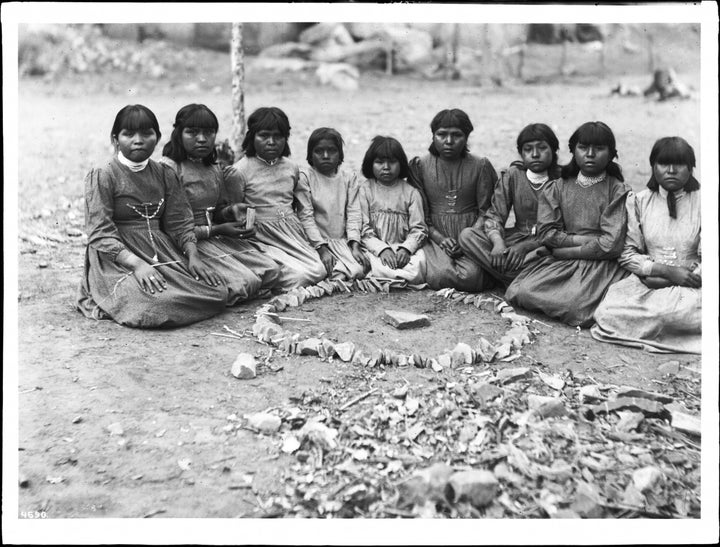
A group of nine Havasupai girls playing a game on their small reservation in the middle of Grand Canyon National Park circa 1898.
Tuesday marked the 99th anniversary of the National Park Service, perhaps the most-loved division of the federal government. For many Americans, excursions to the national parks conjure up memories of family road trips, camp songs and hikes set in some of the country's most beautiful locales. Ken Burns called the parks, "America’s best idea." Cue Woody Guthrie: "This Land Is Your Land."
But what's often left unmentioned is that for the parks to become the protected lands of public imagination, their prior inhabitants -- such as indigenous peoples and the rural poor -- had to be evicted.
To shed light on this history and its perpetuation abroad, indigenous rights advocacy organization Survival International launched a new campaign this month called "Stop the Con," protesting what it describes as the "violent displacement" of indigenous peoples in the name of conservation. The campaign aims to raise awareness about problematic conservation practices.
The campaign began two weeks ago when Tesia Bobrycki, an environmental activist from California, scaled the monolithic granite face of Yosemite National Park's El Capítan and dangled from a rope 3,000 feet above the Yosemite Valley floor. Bobrycki had "Stop the Con," written on her hand, which she proudly displayed to the Survival International cameraman stationed above her on the cliff’s edge.
Bobrycki was calling attention to the fact that, long before Yosemite became a popular tourist destination, the Ahwahneechee Indians who resided in the region knew it as "Ahwahnee," or "gaping mouth-like place." During the Mariposa War in 1851, California soldiers "discovered" the valley while pursuing the AhwahneecheeThe soldiers expelled the Ahwahneechee and renamed their valley "Yosemite." But the Ahwahneechee returned, and worked humiliating jobs entertaining tourists as "Indian performers" to remain in their homeland. The national park finally evicted the last of them and burned down their remaining homes in a fire-fighting drill in 1969.
A spokesperson for the National Park Service referred request for comment to Yosemite National Park's communications department. A representative from Yosemite did not immediately respond to The Huffington Post’s request for comment.
Historian William Cronon began unearthing the forgotten stories of indigenous peoples in the 1980s, followed by others like Mark Spence and Karl Jacoby. Their writings revealed the displacement hidden within enduring romantic ideas about national parks.
"Conservation is used as a tool of colonialism," Jacoby told HuffPost. "Conservation is basically trying to say that ‘We the state and the state bureaucracies, have the appropriate knowledge to manage the environment in the best way," rather than indigenous peoples and other prior inhabitants.
Jacoby’s first book, Crimes Against Nature, draws on case studies from the Adirondacks, Grand Canyon and Yellowstone to demonstrate the history of displacement that underlies American conservation.
"In the 19th century, there is a very strong critique of native environmental practices in a lot of the conservation literature that you read," said Jacoby. "The only way you can come in and say ‘We [the state] need to manage this space and manage the environment,’ is you have to in some ways present the current managers of it -- the native peoples -- as incompetent."
Native peoples, like the Ahwahneechee, however, did not leave their homes in the parks of their own accord and often had to be removed and kept away from their homelands by force. The United States Army, for example, was stationed at Yellowstone from 1886 to 1918 to keep out indigenous peoples and others with the threat of violence.
Jacoby said his scholarship isn't necessarily well-received by conservation advocates. "My book has not made me very popular in environmentalist circles," he added with a laugh.
Survival International points out that today, San people in Botswana, Baka people in southeastern Cameroon, and tribes in India’s tiger reserves face arrest, torture and even death as they try to maintain ancestral homes that are being coopted in the name conservationism -- a brand of exclusionary conservation first practiced in America, the group argues.
"All of this abuse that has been carried out in the name of conservation is still going on," Michael Hurran, spokesman for Survival International, told HuffPost. "It’s high time that it stopped. That’s what this ‘Stop the Con’ campaign is trying to do."

Survival International campaigner Tesia Bobyricki kicked off the organization's "Stop the Con" campaign.
The problem with a neutered history of national parks and conservation, Survival International argues, is that it fails to create the policies that protect the environment.
"Often the real drivers of environmental destruction go unaddressed, things like logging, mining and political corruption, while the lives of the most defenseless people and the least responsible people are ruined or made impossibly difficult," Hurran said. "We are calling for a new model of conservation, a new kind of conservation, that works not against but with tribal peoples who are the best conservationists and guardians of the natural world."
The first step for the organization is to spark a public debate during the park’s centennial year.
"We are trying to stimulate a really public debate about this to get every normal person talking about this and thinking about this -- both the dark history of conservation and what’s happening now, and what conservation could look like in the future," Hurran said.
